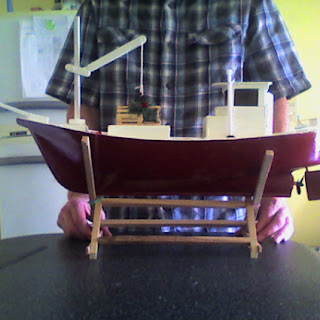This is a how-to blog for people wanting to make and sail a model boat.
This idea was inspired by my grandfather who made a small naval cannon for me when I was four or five. Although at the time I would have preferred a GI-Joe... his gift made me feel a little special.
This is the first model boat I made. It is a model of a lobster fishing boat I saw on a holiday to Prince Edward Island a few months before my daughter was born.
The model is built of popsicle sticks and barbecue skewers and other bits and pieces of recycled material. The windows are plastic from a box of chocolates. The wood is glued together with Elmer's white glue, patched with expoxy body filler, and waterproofed with varnish. I don't know, it's probably toxic as hell but my goal was to use recycled materials.
An alternative to epoxy and super glue would be nice - perhaps carpenter's glue - but epoxy makes a very waterproof hull and provides strength. The epoxy can get be purchased at the supermarket. All the construction materials can be purchased at the supermarket or hardware store.
The radio control gear is the best part. Thanks to China's export-oriented growth strategy and willingness to sell Yuan at a discount, you are able to buy a fully proportional two or three channel radio transmitter and receiver for around US$20 not including shipping.
The electric motor cost about $25. The speed controller was the most expensive part at $35. The driveshaft and propeller cost less than $10.
The batteries are 4 D cell carbon batteries because I did not want to burden the owner with having to manage exotic batteries. These batteries push the boat along at a very realistic pace.
In terms of know-how, making a model boat doesn't require a lot of skill. You should be able to chop carrots in the kitchen without getting your fingers in the way. I've done this as a class project with teenage students who have not used a utility knife before. If you can chop onions successfully you can build a boat with a little practice and patience.






